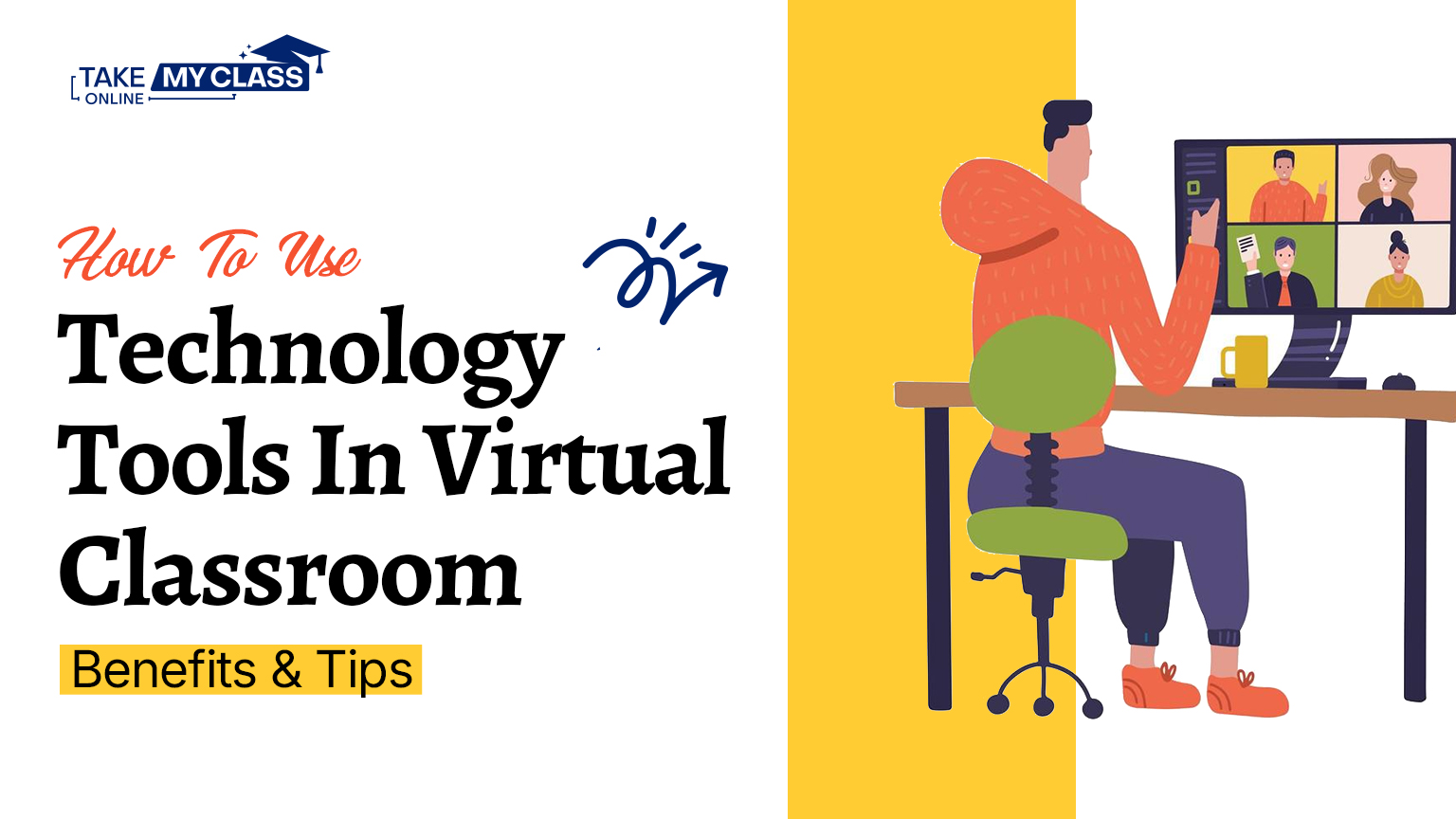
How to Use Technology Tools in virtual Classroom: Benefits & Tips
Technology in the classroom has altered the way that students and teachers interact virtually. Teachers and students alike must quickly adjust to the shift to online learning. Lessons, resources, and support systems are more easily accessible because to technology. Although this change has numerous advantages, it also necessitates well-defined success tactics.
The correct strategy can have a significant impact if you are looking for technology in online class to help or investigating ways to better manage online learning.
The Development of Online Learning Environments
Online class help has expanded significantly in recent years. Digital technologies are increasingly widely used in training programs, schools, and institutions. Learning is now more flexible as a result of this modification. However, it has also brought out new difficulties.
Learning can be improved by using tools effectively. But anarchy can result if you don’t plan. Overworked students may urge someone else to “take my class for me.” A sophisticated online class taker system can be used to prevent that.
Technology’s Importance in the Classroom
Using technology in the classroom facilitates communication between teachers and remote students. It promotes collaboration, prompt feedback, and greater participation.
Among the main benefits are:
- Access to resources and instruction in real time.
- Use of animations, pictures, and movies to make subjects easier to understand.
- Faster feedback and grading via learning tools.
- Cloud storage and digital note-taking make organisation simple.
Even while learning remotely, this class taking service provide students a sense of participation. But how they are used determines everything.
The advantages of using technology in the online learning environment
Utilising the appropriate tools has significant advantages. The following are some benefits of using technology in the classroom:
- Enhances student engagement via interactive instruction.
- Makes use of on-demand video lectures to promote self-paced learning.
- Makes it possible to collaborate in groups using tools like teams, zoom, and google meet.
- Uses learning dashboards and analytics to monitor progress.
- Facilitates the rapid updating and sharing of content by teachers.
- A more structured and adaptable learning environment is made possible by these features.
Typical Technology Tools for the Classroom
Modern online learning environments require the following mechanical assets:
- Video conferencing platforms (such as Zoom and Google Meet): for in-person conversations and meetings.
- Learning administration systems (LMS) like Moodle, Canvas, and Chalkboard are used to handle assignments, grades, and course materials.
- Collaborative Tools: Create amicable projects and brainstorm with Google Docs, Jamboard, and Padlet.
- Employ evaluation platforms like Google Forms, Quizizz, and Kahoot to create simple-to-understand tests.
- Communication tools (Remind, Slack): For updates and real-time chats.
- The tools that instructors and students choose should be guided by the program’s requirements and structure.
How to Maximise Innovation in Distance Learning
You can get help advancing your use of innovation in the classroom by following this helpful advice:
1. Establish Clear Guidelines for Online Behaviour
First, clearly define expectations for behaviour in online courses. Understudies should learn how to participate in civil conversations. Describe the guidelines for advanced behaviour, camera use, quieting receivers, and ease of use. Starting with clarity creates organisation and prevents mistakes. Encourage thoughtfulness and skill in all conversations.
2. Promote Involvement
For innovation to be used effectively in the classroom, students must stay focused during the lesson. Allow understudy to post questions throughout the address. Allow them to respond to each other’s enquiries. Because of this, they remain vigilant and involved. Additionally, true time allows you to assess their comprehension degree.
3. Teach Students to Use Resources
Don’t assume that all people can use computerised stages. Early in the course, devote attention to getting understudy ready. Present them with live demonstrations or quick informational activities or activities that promote use of technology in education. Throughout the lecture, discuss how to participate in virtual sessions, access assignments, transfer records, and communicate. Many future problems can be avoided with a few platform training sessions. Additionally, it gives students who are new to online learning more confidence.
4. Make a Basic Layout
Make sure the course layout is clear and simple to understand. Steer clear of cluttered pages with an excessive number of uploads or links. Make folders and carefully mark the items according to the topic or week. Adhere to standard file naming conventions. It shouldn’t take ten minutes for students to locate a lecture note. Their learning experience improves with a more structured arrangement.
5. Offer a Variety of Content Formats
Information is absorbed differently by various students. While some people learn best by seeing or listening, others prefer to read. Vary your material. When feasible, include audio recordings, brief explanation videos, and lecture slides in PDF format. Interactive tests and infographics also support learning.
6. Maintain Backups
Use of technology isn’t always trustworthy. After every class, download the recordings and arrange them chronologically. Backups enable students catch up if they miss a session and shield you from losing important work.
7. Obtain Input
Get input from students on how the class is doing on a regular basis. Do the tools function properly? Are they simple to use? What difficulties do they have with the digital configuration? To gather information, conduct surveys or have open debates. Feedback aids in your improvement and adaptation. You might find that some platforms make learners feel confused, or that some approaches are more effective. Remain adaptable and prepared to make changes.
Using Tech in the Classroom to Help Students Overcome Their Challenges
When platforms or tools change regularly, some students get lost. This may prompt them to consider employing a class-taking service or hiring an online student. Although some assistance could be beneficial, it is preferable to mentor pupils to develop greater user confidence.
Provide assistance sessions and maintain a consistent toolkit. Instead than trying to get around the technology, let pupils grow with it.
The Value of Being Prepared as an Instructor
Teachers need to be knowledgeable about both the teaching and technical aspects. Errors can be avoided by planning beforehand. Even excellent content can fail if teachers are unfamiliar with the resources.
- Prior to becoming live:
- Test every tool.
- Make a backup plan.
- Make lesson files available.
When teachers and kids feel comfortable using technology in the classroom, it works better.
Maintaining Students’ Interest in Technology
Long virtual sessions might lead to boredom. Short exercises will help students stay focused. Wherever feasible, gamify the learning process. To illustrate concepts, include images and make a tale.
Additionally, you can:
- Permit brief rests.
- Combine group projects with lectures.
- Promote presentations that are led by students.
- These methods help pupils focus better and remember more information.
Privacy and Safety in the Internet Environment
Always abide by privacy guidelines when using technology in an online course. Make use of safe platforms. Don’t divulge private information in public. These rules should be explained to students at an early age by their instructors.
Additionally, be sure to:
- Strong passwords are used.
- Passcodes or waiting areas are used during meetings.
- Secure, encrypted formats are used to store data.
- Both teachers and students are safeguarded by this.
The Use of Technology in the Classroom in the Future
In the future, use of technology in education will only increase. Learning is becoming more immersive because to artificial intelligence, virtual reality, and smart dashboards.
We can anticipate:
- More individualised educational pathways.
- Advanced tracking of student progress.
- Automated reports and evaluations.
As the digital classroom develops, educators and learners who adjust today will reap greater rewards.
Top Techniques for Instructors and Learners
Coordination is necessary on both sides. The following best practices can ensure that innovation is consistently used in the classroom:
- Communicate clearly and consistently.
- Promote inquiry and problem-solving.
- Always be on the lookout for advanced behaviour.
- During live sessions, refrain from multitasking.
- Turn in assignments on time, and seek assistance when required.
- These behaviours foster a more civil and effective learning environment.
Conclusion: Using Technology to Its Full Potential in the Classroom
Effective use of innovation in the classroom can increase student association and involvement. In fact, it brings teachers and students together when they are separated by unusual distances. However, much like any other tool, it works best when adjusted and planned.
Don’t make things more difficult. Take the needs of the understudy into account. Be receptive to criticism and new ideas. In this manner, both teachers and students can fully realise the promise of advanced learning.
As more schools shift their activities online, developing strong technological skills in the classroom is becoming essential for future success.
